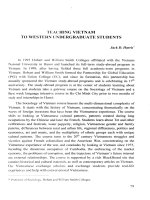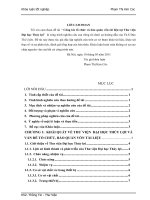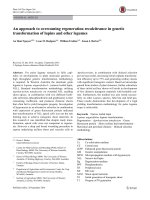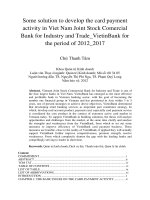DSpace at VNU: Quasipotential approach to quantum chromodynamics
Bạn đang xem bản rút gọn của tài liệu. Xem và tải ngay bản đầy đủ của tài liệu tại đây (97.86 KB, 4 trang )
Theoretical and Mathematical Physics, 132(2): 1144–1147 (2002)
QUASIPOTENTIAL APPROACH TO QUANTUM
CHROMODYNAMICS
Nguyen Van Hieu∗
We use the Logunov–Tavkhelidze quasipotential approach to study some processes of quantum chromodynamics at finite densities and temperatures. The dynamic equation for the color superconductivity is
derived. We discuss the spontaneous breaking of the chiral, flavor, and color symmetries and also the
possibility of constructing a field theory of the composite three-quark systems.
Keywords: quantum chromodynamics, chiral symmetry, flavor symmetry, color symmetry, three-quark
systems
About forty years ago, Logunov and Tavkhelidze proposed the quasipotential approach in quantum
field theory [1]–[4]. This approach is an universal method for studying the bound states of relativistic
two-particle systems and the asymptotic behavior of scattering amplitudes at high energies. It is based on
introducing an energy-dependent quasipotential and using a relativistic Schr¨
odinger-type equation with the
quasipotential. It was then my fortune to work in the collaboration of scientists headed by A. A. Logunov
at the Joint Institute for Nuclear Research. The knowledge and experience in scientific work acquired then
proved of substantial value.
In this paper, we propose using the Logunov–Tavkhelidze quasipotential method to study two relevant
problems in quantum chromodynamics (QCD) at finite densities and temperatures: color superconductivity
and spontaneous symmetry breaking. We also discuss the possibility of constructing a field theory of the
three-quark systems.
1. Color superconductivity
The superconducting pairing of quarks in QCD can occur because of two mechanisms: the gluon
exchange and the instanton-induced quark–quark interactions. The individual contributions of each of
these mechanisms to color superconductivity were considered in many papers [5]–[15]. In the general case,
it is necessary to take both of these mechanisms into account simultaneously. The quasipotential method
using functional integrals is adequate for this purpose.
We use the formalism with imaginary time. Our condensed notation is
β
x = (x, τ ),
dx =
dτ
0
dx,
β=
1
,
kT
where k is the Boltzmann constant and T is the absolute temperature. We let ψA and ψ¯A denote the
respective quark field and its conjugate, where the index A = (α, a, i) describes the set of the spinor index
α = 1, 2, 3, 4, the color symmetry index a = 1, 2, . . . , Nc , and the flavor symmetry index i = 1, 2, . . . , Nf .
∗ National Centre for Natural Sciences and Technology, Hanoi, Vietnam; Faculty of Technology, Vietnam National University - Hanoi, Hanoi, Vietnam, e-mail:
Translated from Teoreticheskaya i Matematicheskaya Fizika, Vol. 132, No. 2, pp. 295–299, August, 2002. Original article submitted October 15, 2001.
1144
0040-5779/02/1322-1144$27.00
c 2002 Plenum Publishing Corporation
The starting point in constructing the theory of color superconductivity is the partition function for the
system of interacting quarks,
Z=
¯ exp −
[Dψ] [Dψ]
× exp
1
2
dx
dx ψ¯A (x)LB
A ψB (x) ×
BD
dy ψ¯A (x)ψ¯C (y)VCA
(x − y)ψD (y)ψB (x) ,
(1)
where
∂
−µ +γ∇+M
∂τ
b j
LB
A = δa δi γ4
β
,
(2)
α
BD
µ and M are the respective chemical potential and the mass of the bare quark, and VCA
(x − y) is the
quasipotential. For simplicity, we consider the approximation in which the quasipotential depends only on
the difference x − y of the two coordinates. Our considerations are easily applicable to the general case
where the complex quasipotential depends on the differences of the various coordinates of all four quark
fields.
AC
We introduce the bilocal bispinor composite fields ΦAC (x, y) and their conjugates Φ (x, y) satisfying
the Fermi–Dirac statistics,
ΦCA (y, x) = −ΦAC (x, y),
Φ
CA
(y, x) = −Φ
AC
(x, y),
and apply the Hubbard–Stratonovich transformation. Then the partition function Z can be represented as
the functional integral in the composite fields,
Z=
[DΦ] [DΦ] exp Seff [Φ, Φ] ,
(3)
with some effective action Seff [Φ, Φ]. The equations for the composite fields
δSeff [Φ, Φ]
δΦ
AC
=0
(4)
(x, y)
following from the principle of extreme action are the generalized BCS equations for the order parameter of
the flavor superconductivity. These equations were considered for particular cases of specific mechanisms of
quark–quark pairing in [5]–[14]. The quasipotential approach using the functional integrals [15] is the unique
method for studying the general case where both mechanisms of quark–quark pairing operate simultaneously.
2. Spontaneous symmetry breaking
The presence of the nonzero order parameters ΦAB results in the spontaneous breaking of the corresponding symmetry properties of the interacting quark systems with finite density and temperature.
Because these order parameters are the second-rank spinors (with two indices a, b = 1, 2, 3) of the color
symmetry group SU (3)c , they contribute to the matrix elements of the various processes breaking the color
symmetry including the processes of transmutation of a photon into a gluon and vice versa (photon–gluon
mixing) [16]. In addition, breaking the gauge color symmetry SU (3)c gives rise to a nonzero mass of the
gluon with the appropriate quantum numbers of the group SU (3)c . Because of the photon–gluon mixing,
this massive gluon of the quantum chromodynamics of matter at finite densities and temperatures decays
1145
into electron–positron pairs. This process can serve as experimental evidence for the quark–gluon plasma
formation.
Quantum chromodynamics with the zero mass of the bare quark has the chiral symmetry. The presence
of the nonzero order parameters ΦAB gives rise to a nonzero mass of the quarks and thus spontaneously
breaks the chiral symmetry. Another mechanism for the spontaneous chiral symmetry breaking is the
quark–antiquark pairing.
To study the quark–antiquark pairing [17], [18], we use partition function (1) in a somewhat different
form:
¯ exp −
[Dψ] [Dψ]
Z=
× exp
1
2
dx
dx ψ¯A (x)LB
A ψB (x) ×
BD
dy ψ¯A (x)ψB (y)UAC
(x − y)ψ¯C (y)ψD (x) ,
(5)
BD
where the quasipotential is denoted by UAC
(x − y). We introduce the composite bilocal meson fields
A
ΦB (x, y) with the transformation properties of the product ψ¯A (x)ψB (y). Using the Hubbard–Stratonovich
transformation, we represent partition function (5) as the functional integral in the meson fields,
Z=
[DΦ] exp Seff [Φ]
(6)
with some effective action Seff [Φ]. The equations for the composite meson fields
δSeff [Φ]
=0
δΦA
B (x, y)
(7)
following from the principle of extreme action are the dynamic equations for defining the order parameters
of the interacting quark system in the presence of quark–antiquark pairing. If these order parameters are
the singlets of the color and flavor symmetry groups, they give rise only to the spontaneous chiral symmetry
breaking. It was shown that in the case of the flavor symmetry group SU (2), there exist nonzero order
parameters forming a triplet of this group and the flavor symmetry is therefore spontaneously broken [18].
But there is a degeneration between the phases with the triplet and the singlet order parameters if the
quark–quark interactions are induced by the instantons.
3. Formation of the triquark
The quasipotential approach proves a rather convenient method for studying the formation of the
triquark, the bound state of the three-quark system in QCD. For this purpose, we use the functional
integral for the interacting quark system in the form
Z=
¯ exp −i
[Dψ] [Dψ]
× exp
i
6
d4 x
d4 y
ˆ B + mδ B ]ψB (x) ×
d4 x ψ¯A (x)[(∂)
A
A
d4 z
d4 u
d4 v
CAB
(u, v, w; z, y, x)ψA (x)ψB (y)ψC (z)
× VDEF
d4 w ψ¯F (w)ψ¯E (v)ψ¯D (u) ×
(8)
CBA
with some quasipotential VDEF
(u, v, w; z, y, x) of the interaction between three quarks. Introducing the
composite trilocal trispinor baryon fields ΨABC (x, y, z) and their conjugates ΨABC (x, y, z) and performing
1146
the corresponding Hubbard–Stratonovich transformation, we obtain functional integral (8) in the form
Z=
[DΨ] [DΨ] exp iSeff [Ψ, Ψ]
(9)
with some effective action Seff [Ψ, Ψ]. The equations for the composite fields
δSeff [Ψ, Ψ]
ABC
δΨ
=0
(10)
(x, y, z)
following from the principle of extreme action are the system of dynamic integral equations for the bound
states of the three-quark system. These equations were obtained in [19]. The further study of their solutions
is an interesting problem in hadron physics.
REFERENCES
1.
2.
3.
4.
5.
6.
7.
8.
9.
10.
11.
12.
13.
14.
15.
16.
17.
18.
19.
A. A. Logunov and A. N. Tavkhelidze, Nuovo Cimento, 29, 380 (1963).
A. A. Logunov, A. N. Tavkhelidze, I. T. Todorov, and O. A. Khrustalev, Nuovo Cimento, 30, 134 (1963).
A. A. Logunov, Nguyen Van Hieu, and O. A. Khrustalev, Nucl. Phys., 50, 295 (1964).
Nguyen Van Hieu and R. N. Faustov, Nucl. Phys., 53, 337 (1964).
M. Alford, K. Rajagopal, and F. Wilczek, Phys. Lett. B, 422, 247 (1998); Nucl. Phys. B, 537, 443 (1999).
T. Sch¨
afer and F. Wilczek, Phys. Rev. Lett., 82, 3956 (1999); Phys. Lett. B, 450, 325 (1999).
R. Rapp, T. Sch¨
afer, E. Shuryak, and M. Velkovsky, Phys. Rev. Lett., 81, 53 (1998).
N. Evans, S. Hsu, and M. Schwetz, Nucl. Phys. B, 551, 275 (1999); Phys. Lett. B, 449, 281 (1999).
D. T. Son, Phys. Rev. D, 59, 094019 (1998).
G. W. Carter and D. Diakonov, Phys. Rev. D, 60, 01004 (1999).
A. Chodos, H. Minakata, and F. Cooper, Phys. Lett. B, 449, 260 (1999).
T. Sch¨
afer and F. Wilczek, Phys. Rev. D, 60, 074014, 114033 (1999).
V. A. Miransky, I. A. Shovkovy, and L. C. Wijewardhava, Phys. Lett. B, 468, 270 (1999).
R. Casalbuoni and R. Gatto, Phys. Lett. B, 464, 111 (1999).
Nguyen Van Hieu, Basics of Functional Integral Technique in Quantum Field Theory of Many-Body Systems,
VNUH Pub., Hanoi (1999).
Nguyen Van Hieu and Pham Xuan Yem, Phys. Rev. D, 64, 074009 (2001).
M. Harada and A. Shibata, Phys. Rev. D, 59, 014010 (1998).
Nguyen Van Hieu, Nguyen Hung Son, Ngo Van Thanh, and Hoang Ba Thang, Adv. Nat. Sci., 1, 61 (2000);
hep-ph/0001251 (2000).
Nguyen Van Hieu, Adv. Nat. Sci., 2, 115 (2001).
1147









